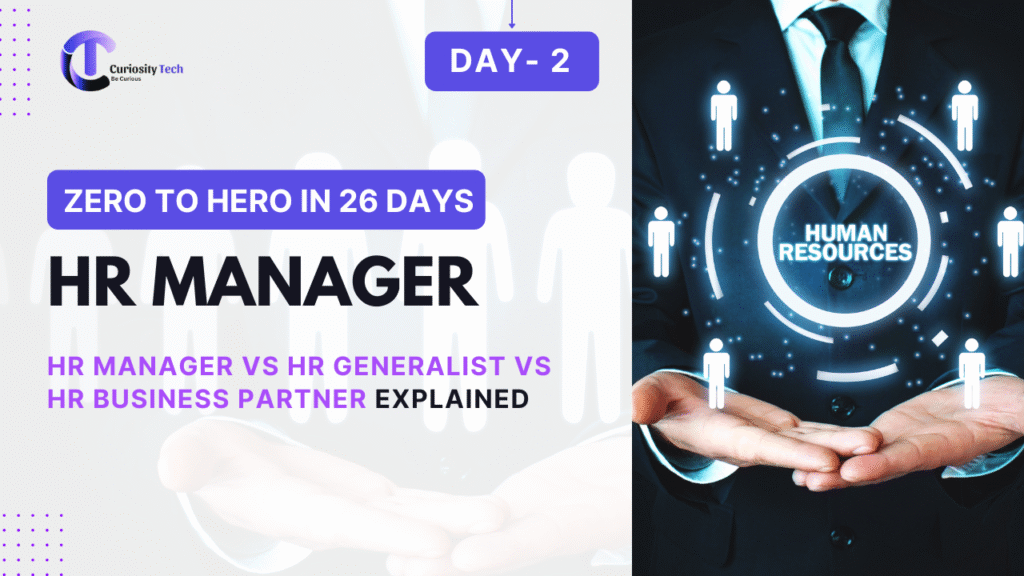In the dynamic world of human resources, understanding the nuanced roles of HR professionals is essential for both aspiring HR leaders and business managers. Often, titles like HR Manager, HR Generalist, and HR Business Partner (HRBP) are thrown around interchangeably, but in reality, each role has distinct responsibilities, strategic importance, and career trajectories. At Curiosity Tech, we believe clarity in these roles is crucial for building strong organizational culture and performance, which is why this guide dives deep into each role, explaining their functions, hierarchy, and impact on businesses.
Understanding the Core HR Roles
1. HR Manager
An HR Manager is primarily responsible for overseeing HR operations and ensuring that policies and procedures align with company goals. They often act as the bridge between the HR team and organizational leadership.
Key Responsibilities:
- Developing and implementing HR policies.
- Managing recruitment, onboarding, and employee relations.
- Overseeing payroll, benefits, and compliance.
- Coaching and mentoring HR staff.
Skills Required:
- Strong leadership and decision-making.
- Conflict resolution and employee engagement.
- Knowledge of labor laws and compliance standards.
2. HR Generalist
An HR Generalist is the all-rounder of the HR department, handling a variety of tasks across HR functions. This role is often a stepping stone for those aiming for managerial positions.
Key Responsibilities:
- Recruitment and talent acquisition.
- Performance management and training coordination.
- Employee relations and policy enforcement.
- Assisting in HR projects and reporting.
Skills Required:
- Multitasking and adaptability.
- Broad knowledge of HR processes.
- Analytical thinking for HR metrics and data.
3. HR Business Partner (HRBP)
The HR Business Partner goes beyond traditional HR functions to align human resources strategy with business objectives. HRBPs act as strategic advisors to management, ensuring that HR initiatives drive business growth.
Key Responsibilities:
- Collaborating with leadership to forecast talent needs.
- Driving change management and organizational development.
- Implementing HR programs that impact business performance.
- Advising managers on complex employee relations and organizational strategy.
Skills Required:
- Strategic thinking and business acumen.
- Excellent communication and stakeholder management.
- Proficiency in HR analytics and workforce planning.
Hierarchical Diagram of HR Roles
Here’s a simplified visual to understand the hierarchy and interaction among these roles:
| Position | Focus Area | Strategic vs Operational |
| HR Business Partner (HRBP) | Aligns HR with business strategy | Strategic |
| HR Manager | Leads HR team and operations | Mix of Strategic & Operational |
| HR Generalist | Handles day-to-day HR functions | Operational |
Infographic Idea: A pyramid showing HRBP at the top (strategic), HR Manager in the middle, and HR Generalist at the base (operational), with arrows indicating collaboration and reporting flow.
How These Roles Interact
While their responsibilities differ, these roles often collaborate to ensure a seamless HR function:
- HR Generalist executes daily HR tasks and provides critical support.
- HR Manager oversees generalists and ensures alignment with policies.
- HRBP provides insights and strategies to leadership, shaping organizational direction.
At Curiosity Tech, we emphasize a synergy between operational excellence and strategic HR planning. For example, our HR team works closely with project managers and leadership to anticipate talent needs for innovative projects, while generalists ensure smooth employee experience and engagement across departments.
Why Understanding These Roles Matters
Knowing the distinctions among HR roles is vital for:
- Career planning for HR aspirants.
- Organizations seeking to optimize HR efficiency.
- Improving employee experience and strategic impact.
Whether you’re aiming to become an HRBP or hiring your first HR Manager, understanding the nuances ensures better decisions, smoother operations, and stronger organizational culture.
Conclusion
HR is no longer just about hiring and payroll; it is a strategic function that directly influences business success. By distinguishing between HR Managers, HR Generalists, and HR Business Partners, companies can better allocate resources, create effective HR strategies, and enhance employee satisfaction. Curiosity Tech continues to support organizations in building HR frameworks that are both efficient and forward-thinking, helping businesses grow sustainably while keeping employee engagement at the forefront.


